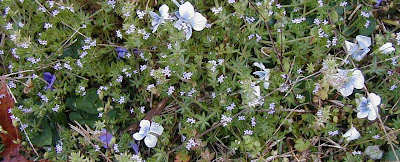The backyard bird community is in transition as winter resident birds are getting ready to head to their summer breeding range, year round resident birds are setting up their territories and beginning to build their nests, summer (breeding) residents are starting to arrive, and neotropical migratory birds from Central and South America are slowly beginning to pass through Georgia on their way north to their summer breeding grounds.

Once or twice a week I will do an early morning bird count to see what birds are waking up in our backyard. Over time we will be able observe the transition of the backyard bird community.
Here is this morning's list. I have indicated if the bird is a year round resident, winter resident, summer resident, or a migrant just passing through. I have also indicated the conservation status of each species.
Eastern Towhee (
Pipilo erythrophthalmus)
Year Round Resident,
Populations declining throughout range
Northern Mockingbird (
Mimus polyglottos)
Year Round Resident, Common and widespread
Northern Cardinal (
Cardinalis cardinalis)
Year Round Resident, Population density and range increasing
Cedar Waxwing (
Bombycilla cedrorum)
Winter Resident, Populations increasing throughout range
Red-bellied Woodpecker (
Melanerpes carolinus)
Year Round Resident, Populations are increasing throughout most of the range
Tufted Titmouse (Baeolophus bicolor)
Year Round Resident, Populations increasing and expanding range northward
White-throated Sparrow (
Zonotrichia albicollis)
Winter Resident, Declining over much of breeding range
Song Sparrow (
Melospiza melodia)
Year Round Resident, Widespread and common in urban and suburban areas
Chipping Sparrow (
Spizella passerine)
Year Round Resident
Populations appear healthy
Eastern Phoebe (
Sayornis phoebe)
Year Round Resident
Populations stable
House Wren (
Troglodytes aedon)
Summer (Breeding) Resident
Populations have increased
Carolina Wren (
Thryothorus ludovicianus)
Year Round Resident, Populations stable or increasing
Carolina Chickadee (
Poecile carolinensis)
Year Round Resident, Slight, but significant population decreases across range
Brown-headed Nuthatch (
Sitta pusilla)
Year Round Resident,
Decreasing because of habitat degradation
Brown Thrasher (Toxostoma rufum)
Year Round Resident, Populations declining slowly throughout range
Blue Jay (
Cyanocitta cristata)
Year Round Resident, There is a slight but significant decline in Blue Jay numbers across the
United States, with most of the decline in the East
House Finch (
Cyanocitta cristata)
Year Round Resident, Common and benefiting from human development
American Robin (Turdus migratorius)
Year Round Resident, Populations stable or increasing throughout its range
For more information on point counts, visit the Point Count Database: www.pwrc.usgs.gov/point/
References:
http://www.birds.cornell.edu/AllAboutBirds/BirdGuide
 It is easy to make your own feeder. The supplies you will need include: a plastic plant saucer, household twine, and a drill with a small bit.
It is easy to make your own feeder. The supplies you will need include: a plastic plant saucer, household twine, and a drill with a small bit.




























